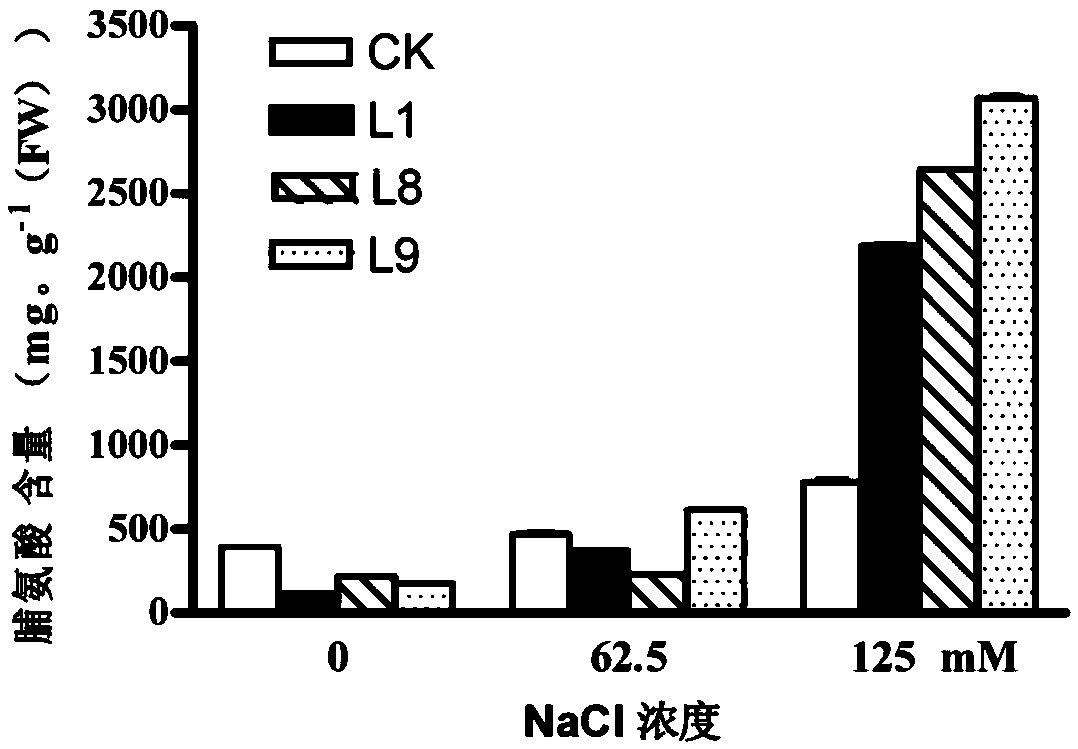Medicago sativa hydroxyphenylpyruvic acid dioxygenase gene and application
A technology of pyruvate dioxygenase and alfalfa, applied in the field of molecular biology, can solve the problems of long growth cycle, delayed gene function, difficult genetic transformation and the like, and achieve the effect of increasing the content
- Summary
- Abstract
- Description
- Claims
- Application Information
AI Technical Summary
Problems solved by technology
Method used
Image
Examples
Embodiment 1
[0022] Embodiment 1 Preparation of alfalfa p-hydroxyphenylpyruvate dioxygenase gene MsHPPD
[0023] The alfalfa MsHPPD gene provided by the invention is screened by the following method:
[0024] Through BLAST comparative analysis, primers were designed according to the conserved domain of the cloned p-hydroxyphenylpyruvate dioxygenase gene (Genbank accession number: XM_003617343) in alfalfa (RT-PCR primer: F: 5'-CCACTTTCTCCGCATCCACTTGTTTC-3 ', its nucleotide sequence is shown in SEQ ID NO: 2 in the sequence listing; R: 5'-CCTCCAATGTCCTAAATATATCCTCAG-3', its nucleotide sequence is shown in SEQ ID NO: 3 in the sequence listing). Amplify from alfalfa (MedicagosativaL.cv.ZhongmuNo.1, Zhongmu No. 1, Beijing China Animal Science and Technology Co., Ltd.), and recover a fragment with an expected size of 600bp (recover a fragment of this length after running electrophoresis) , the recovered fragments were connected into PMD18-TVector (Takara), and the sequencing results were analyze...
Embodiment 2
[0065] Example 2 Agrobacterium-mediated MsHPPD gene transformation of Arabidopsis plants
[0066] 1.1. Materials and reagents
[0067] 1.1.1. Plant material
[0068] The tested alfalfa variety was Medicago sativa L.cv.Zhongmu No.1, Zhongmu No.1.
[0069] 1.1.2. Agrobacterium strains and plasmid vectors
[0070] The Agrobacterium strain used is Agrobacterium tumefaciens: LBA4404 (Beijing Tianenze Gene Technology Co., Ltd.)
[0071] Agrobacterium culture medium:
[0072] Reagent
Content (1L)
MgSO 4 .7H 2 o
1g / L
Peptone
10g / L
Yeast extract
1g / L
5g / L
15g / L
pH
7.0
[0073] 121℃ high pressure steam sterilization for 20min; carrier: PBI121
[0074] 1.2. Experimental method
[0075] 1.2.1 Insert the MsHPPD gene into the pBI121 vector plasmid DNA, the specific steps are: design the upstream primer containing the XbaI restriction site at the 5' end and the downst...
Embodiment 3
[0095] The pBI121 carrier Arabidopsis vitamin E content evaluation of embodiment 3MsHPPD gene
[0096] Agrobacterium was transformed with plasmid pBI121 to obtain recombinant Agrobacterium, and Arabidopsis was transformed with recombinant Agrobacterium to obtain a control plant that was transformed into an empty vector. The method was as in Example 1, and the control plant (CK) that was transformed into an empty vector was obtained as Comparative Example 1.
[0097] Evaluate the vitamin E content of the Arabidopsis thaliana of the transfer empty vector obtained in comparative example 1 and the pBI121 carrier Arabidopsis thaliana that the transformation that obtains in embodiment 1 is inserted into MsHPPD gene, specific method is as follows:
[0098] Mix 3g of alfalfa leaves, grind them evenly, then sample 0.03-0.05g, add 1mL of methanol:chloroform (2:1 / V:V) containing 0.01% of 2,6-di-tert-butyl-p-cresol (BHT), avoid Light standing for 20min. Add 0.33mL chloroform and 0.6mL wa...
PUM
 Login to View More
Login to View More Abstract
Description
Claims
Application Information
 Login to View More
Login to View More - R&D
- Intellectual Property
- Life Sciences
- Materials
- Tech Scout
- Unparalleled Data Quality
- Higher Quality Content
- 60% Fewer Hallucinations
Browse by: Latest US Patents, China's latest patents, Technical Efficacy Thesaurus, Application Domain, Technology Topic, Popular Technical Reports.
© 2025 PatSnap. All rights reserved.Legal|Privacy policy|Modern Slavery Act Transparency Statement|Sitemap|About US| Contact US: help@patsnap.com



